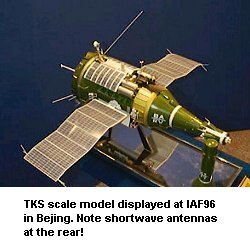 Contents
ContentsSven Grahn
 Contents
ContentsThe TKS series of spacecraft were very enigmatic when they flew, but now we know more about their fascinating history as part of the manned space station program of the Soviet Union. Some of the characteristics of the telemetry from these craft are still obscure. (See the summary).
(For more details about telemetry from Kosmos 929, please refer to the SPACEFLIGHT magazine [published by the British Interplanetery Society], Volume 20, Double-issue for Sept-Oct 1978, pp. 353-355)
Shortwave telemetry (19.954 MHz) Continously transmitted frequency-shift-keyed pulse-duration modulated signals on 19.954 MHz. Each 16 second long telemetry frame contained one synchronization word and 15 data words, just like the telemetry system used on early reconnaisance satellites in the Kosmos series. A similar system was used on the early Soyuzes in which the carrier was keyed on-off instead of shifted 1 kHz to mark word pulses.
The peculiar feature about Kosmos 929 shortwave telemetry was that two separate telemetry modes were transmitted in time sharing on the same channel. Each telemetry mode had access to the transmitter for 30 minutes. The change of mode could occur at any word within the frame being transmitted. Slightly different transmitter frequencies were used for the two modes. One mode had the centre frequency 19.9535 MHz and the other used 19.9545 MHz. In general the values of the data words transmitted in the two modes were quite similar with the exception of word 14 which was always 15 units (max word length=30 units) long in one mode and 23 units in the other mode. Other words changed value during the flight, but the change in word values were qualitatively similar between the two telemetry modes. The question is: Why were there two telemetry systems that were monitoring subsystems that behaved similarly, but not identically? What were these subsystems?
VHF telemetry (166.0 MHz) Kosmos 929 emitted pulse-position modulated AM transmissions on 166.0 MHz similar to those emitted by earlys Soyuzes, Progresses and a large group of other Soviet spacecraft. These rather standrad-type teletry signals were commanded on while the spacecraft was within view of tracking stations in the Soviet Union. Telemetry signals on this frequency were only picked up until 16 August 1977. On the next try on 20 August this signal was gone. It is believed that the re-entry capsule was recovered during this interval.
VHF telemetry (247 MHz) Kosmos 929 transmitted PCM-FM signals near 247 MHz just like its successors. These signals were not detected at the time, but found four years later by analyzing radiospectrogrammes from a solar radio spectrograph located in Central Europe.
This was the TKS vehicle that docked to Salyut 6 on 19 June 1981 after having dropped the re-entry capsule on 24 May 1981.
Shortwave telemetry (19.954 MHz) Again, there were two modes with similar word lengths in most most words, but the period between modes had been reduced to 10 minutes and the two modes were transmitted on exactly the same frequency.
Shortwave telemetry (19.942 MHz) Another telemetry transmitter was discovered on 19.942 MHz. The signal type was the same as that on 19.954 MHz, but the word lengths were much different. This signal appeared only intermittently.
VHF telemetry (247.0 MHz) PCM-FM signals at 247.0 MHz on ground command similar in modulation to those transmitted by todays's Soyuzes and Progresses. This telemetry was also picked up in the U.S.A. The command-on of the signals over the U.S. indicated that there were tracking ships out to support this mission. There were no signals on 166.0 MHz from Kosmos 1267.
This was the TKS vehicle that docked to Salyut 7 10 March 1983 and dropped the re-entry capsule on 23 August 1983.
Shortwave telemetry (19.954 MHz) This time there was only one telemetry mode, continous telemetry on 19.954 MHz. There were no signals on 19.942 MHz from Kosmos 1443.
VHF telemetry (247.0 MHz) PCM-FM signals at 247.0 MHz on ground command similar in modulation to those transmitted by todays's Soyuzes and Progresses. There were no signals on 166.0 MHz from Kosmos 1443.
This was the TKS without the re-entry capsule vehicle that docked to Salyut 7 on 2 October 1985.
Shortwave telemetry (19.954 MHz) Again only one telemetry mode, continuous on 19.954 MHz. There were no signals on 19.942 MHz from Kosmos 1686.
VHF telemetry (247.475 MHz) PCM-FM signals at 247.475 MHz (center frequency) on ground command similar in modulation to those transmitted by todays's Soyuzes and Progresses.
VHF telemetry (247.500 MHz) PCM-FM signals on 247.500 MHz (center frequency) heard long after leaving the Kvant module at Mir. Last picked up 8 January 1988.
| Spacecraft | Shortwave 1 (MHz) | Shortwave 2 (MHz) | VHF 1 (MHz) | VHF 2 (MHz) |
|---|---|---|---|---|
| Kosmos 929 | - | 19.954 | 166.0 | 247 |
| Kosmos 1267 | 19.942 | 19.954 | - | 247 |
| Kosmos 1443 | - | 19.954 | - | 247 |
| Kosmos 1686 | - | 19.954 | - | 247.475 |
| Kvant Service Pod | - | - | - | 247.500 |
The big question is still: Why was there dual-mode telemetry on Kosmos 929 and Kosmos 1267? Which two subassemblies were so similar, but still seemingly independent?
![]()